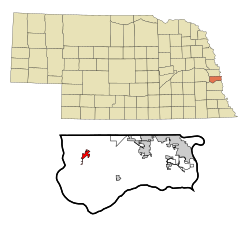2020 census
As of the 2020 census, [3] there were 5,083 people, 2,020 households, and 1,293 families in Gretna. The population density was 743.1 per square mile (287.0/km2). There were 2,103 housing units at an average density of 307.5 per square mile (118.7/km2). The racial makeup was 92.5% (4,702) white, 0.53% (27) black or African-American, 0.26% (13) Native American, 0.47% (24) Asian, 0.06% (3) Pacific Islander, 1.02% (52) from other races, and 5.15% (262) from two or more races. Hispanic or Latino of any race was 5.0% (268) of the population.
Of the 2,020 households, 31.8% had children under the age of 18; 47.0% were married couples living together; 33.2% had a female householder with no husband present. 31.5% of households consisted of individuals and 15.8% had someone living alone who was 65 years of age or older. The average household size was 2.5 and the average family size was 3.2.
25.3% of the population was under the age of 18, 8.2% from 18 to 24, 28.3% from 25 to 44, 24.3% from 45 to 64, and 13.2% who were 65 years of age or older. The median age was 36.2 years. For every 100 females, the population had 83.5 males. For every 100 females ages 18 and older, there were 87.0 males.
The 2016-2020 5-year American Community Survey [10] estimates show that the median household income was $69,592 (with a margin of error of +/- $21,688) and the median family income $102,646 (+/- $14,567). Males had a median income of $55,159 (+/- $8,524) versus $39,627 (+/- $3,278) for females. The median income for those above 16 years old was $45,473 (+/- $7,973). Approximately, 6.7% of families and 6.5% of the population were below the poverty line, including 8.6% of those under the age of 18 and 12.5% of those ages 65 or over.
2010 census
As of the 2010 census, there were 4,441 people, 1,594 households, and 1,139 families living in the city. The population density was 2,114.8 inhabitants per square mile (816.5/km2). There were 1,671 housing units at an average density of 795.7 per square mile (307.2/km2). The racial makeup of the city was 97.4% White, 0.6% African American, 0.1% Native American, 0.5% Asian, 0.3% from other races, and 1.1% from two or more races. Hispanic or Latino of any race were 1.6% of the population.
There were 1,594 households, of which 43.8% had children under the age of 18 living with them, 56.7% were married couples living together, 11.2% had a female householder with no husband present, 3.6% had a male householder with no wife present, and 28.5% were non-families. 24.5% of all households were made up of individuals, and 10.1% had someone living alone who was 65 years of age or older. The average household size was 2.72 and the average family size was 3.29.
The median age in the city was 34.5 years. 31.7% of residents were under the age of 18; 5.8% were between the ages of 18 and 24; 28.7% were from 25 to 44; 21.4% were from 45 to 64; and 12.4% were 65 years of age or older. The gender makeup of the city was 49.0% male and 51.0% female.




